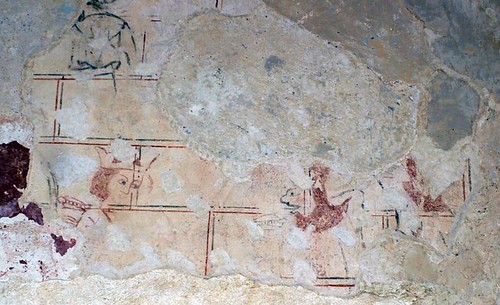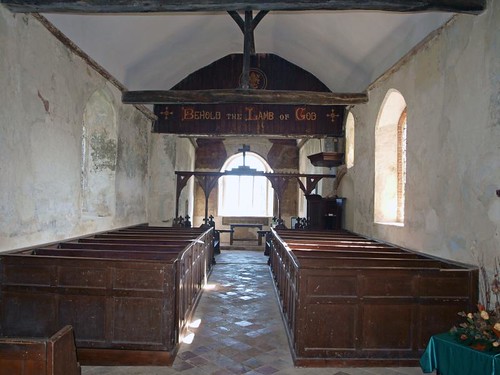ST MARY. Nave and chancel and a timber tower, remarkable in design though hardly higher than the nave roof. Square centre with N, S, and W aisles, the W aisle connected by triangular pieces to N and S aisles (cf. Navestock). The aisle roofs are tiled and start about 8 ft from the ground. The square upper part is boarded. The nave has an early C14 N window with Y-tracery. A brick window and a blocked archway into a chapel on the S side must be early C16. The chancel is early C18. Of brick with original E and N windows. Timber N porch with V pendants hanging from the lower eaves ends of the gable. Humble interior with box-pews and candleholders on them. - PLATE. Jacobean Cup on a stem for which the Royal Commission suggests a pre-Reformation date.
MUNDON. Odd to look at and lonely in its situation, its church gives us an impression of a day that has passed. An ivied elm and a ragged yew grow at its rustic gate, behind a barn of Stuart days keeping company with its great house, and round it all run traces of a moat which must have been filled with water in the days of the Barons. From those days comes the church’s oldest possession, the Norman font made square 800 years ago but given the fashionable shape of a later day by cutting off its corners. One of the oldest bells in the county still rings as it has rung for more than 500 years. The timber belfry was erected for it in Tudor days, and a very quaint addition it is, half an octagon fitted round the west wall. The same carpenters may have built the porch, with a gable of moulded bargeboards and spandrels carved with twisted leaves.
Simon K -
After half a mile a lane ran off to the hall, high hedged and just about wide enough for two cars to pass, as long as they breathed in. The lane ran for a mile, and then I was directed for about a quarter of a mile down a dirt track to my goal.
Open. The west end is so familiar to me from photographs there was a little shock of recognition. The half timbered belfry curves around the little red brick building. The tiny churchyard is surrounded by woodland. It was silent apart from the birdsong.
Walking around, I found it to be a long, little church, if that makes sense. Utterly rustic, entirely vernacular. You step into darkness - obviously, there is no electricity - and the western quarter of the building is a simple crooked wooden structure, then you step through a low arch into a Norman church with 18th Century furnishings. Sounds idyllic, doesn't it. And it is.
It was shattered by a stray V1 in 1944, patched up in the late 1940s and then abandoned by the parish. By the 1960s it was roofless and overgrown. In 1970, the Diocese obtained a demolition order to get rid of it.
And then in 1973 the Friends of Friendless Churches obtained the lease. There was a restoration lasting three years at the hands of Laurence King, whose copy of Cox's 'English Church Furnishings' I had found in a Felixstowe bookshop earlier in the week. The Courtauld Institute rescued and stabilised the wall paintings. The 18th Century furnishings were repaired and restored. The east wall had to be rebuilt, and the wooden west end is apparently entirely unconnected to the rest of the church, because they move at different rates.
This is Essex's equivalent of Suffolk's Badley, and if it doesn't have the brasses that Badley has, the atmospheres are of a piece. The church is left open all the time. This is one of the loveliest churches I have visited in England.
I wandered around the graveyard and saw things that will be invisible in a couple of months - cast iron markers from the Maldon foundry, rare wooden gravemarkers, idiosyncratic headstones from local masons. Oh, and a human thigh bone!
Flickr.
Simon K -
This church was the real goal of my journey. Knowing how horrible Latchingdon was I was a bit uncertain about the setting of the next, but I needn't have worried. Two miles or so took me halfway to Maldon, and then a tiny lane ran off at a crossroads warning me it was a dead end and very narrow.
Open. The west end is so familiar to me from photographs there was a little shock of recognition. The half timbered belfry curves around the little red brick building. The tiny churchyard is surrounded by woodland. It was silent apart from the birdsong.
Walking around, I found it to be a long, little church, if that makes sense. Utterly rustic, entirely vernacular. You step into darkness - obviously, there is no electricity - and the western quarter of the building is a simple crooked wooden structure, then you step through a low arch into a Norman church with 18th Century furnishings. Sounds idyllic, doesn't it. And it is.
It was shattered by a stray V1 in 1944, patched up in the late 1940s and then abandoned by the parish. By the 1960s it was roofless and overgrown. In 1970, the Diocese obtained a demolition order to get rid of it.
And then in 1973 the Friends of Friendless Churches obtained the lease. There was a restoration lasting three years at the hands of Laurence King, whose copy of Cox's 'English Church Furnishings' I had found in a Felixstowe bookshop earlier in the week. The Courtauld Institute rescued and stabilised the wall paintings. The 18th Century furnishings were repaired and restored. The east wall had to be rebuilt, and the wooden west end is apparently entirely unconnected to the rest of the church, because they move at different rates.
This is Essex's equivalent of Suffolk's Badley, and if it doesn't have the brasses that Badley has, the atmospheres are of a piece. The church is left open all the time. This is one of the loveliest churches I have visited in England.
I wandered around the graveyard and saw things that will be invisible in a couple of months - cast iron markers from the Maldon foundry, rare wooden gravemarkers, idiosyncratic headstones from local masons. Oh, and a human thigh bone!
I stayed here nearly an hour in all, but then it was time to start heading homewards.
Flickr.



No comments:
Post a Comment